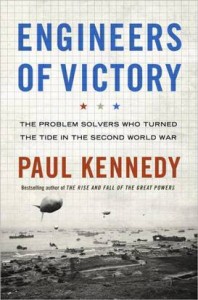Most books on military history focus either on the super-sized personalities and dazzling strategic vision of the generals at the top, or on the dramatic and courageous exploits of the grunts on the ground, sea or air. My father was one of the warfighters, so I have immense respect for everything they experienced and achieved.
Yet I’m glad that Paul Kennedy has written a book that focuses on the achievements of the middle managers, the nameless scientists, engineers, logisticians and trainers who worked tirelessly to solve the problems and provide the tools needed for victory. In hindsight, the outcome of the war may seem inevitable, but to those in the thick of it, it was a very close-run thing.
In January 1943, Franklin Roosevelt and Winston Churchill, along with their top generals and military advisers, met in Casablanca to plot their grand strategy to defeat the Axis powers. At the time, their situation was perhaps not as bleak as it had been just a few months prior—the allies had averted disaster and were no longer in imminent danger of losing the war—but they were still a long way from winning it. At the summit, the strategists agreed on a clear recipe for winning the war. It was actually pretty simple:
- First, they had to stop the German U-boats from sinking ships faster that they could build them, so they could feed England and build up the forces necessary to invade Europe.
- Second, they had to destroy the vaunted German air force so that they could weaken German industry and control the air to make an invasion possible.
- They also had to keep from losing the war in the meantime, by figuring out how to defeat the German blitzkrieg tactics, a task that every other country in Europe had previously found impossible to achieve.
- Finally, they had to get a vast army ashore against a well-defended and so-far invincible army.
- Oh, and by the way, they simultaneously had to figure out how to beat the Japanese across thousands of miles of empty ocean dotted with impregnable fortresses.
The strategy was a masterpiece, and in the end it turned out to be exactly how the war was won. The only problem is that no one knew how to do any of these simple tasks. It’s like the recipe for rabbit soup: First, catch one rabbit. (Except that this rabbit bites back, and is as well-armed as you are.)
The goals were like interlocking pieces of a puzzle—failure at one meant likely failure of the others. At the time those five goals were set, no one knew exactly how or if any of them could be accomplished. The strategic genius of the leaders depended on whether the middle managers could figure out the approaches and get things done. These were the organizers, scientists, engineers, and trainers that solved the problems, made things work, invented the necessary tools.
In the book, the engineers of victory included the operations analysts who figured out the proper distribution and depth settings for depth charges; the trainers who turned out crews (as many as 10 in the B-17) to man the tens of thousands of aircraft produced yearly; the logisticians who fed, armed, and clothed millions of troops spread literally around the world; the engineers who designed, built and transported mobile pontoon bridges to span the wide Russian rivers; the organizers who coordinated the movements of an incredible 2,700 vessels, 130,000 men and 12,000 aircraft on D-Day—without a single computer.
Kennedy defines the term engineers broadly as any problem solver, so the book is not just about technology. In fact, individual technological breakthroughs are not as effective unless they are part of a system. A great example of this is the P-51 Mustang fighter, which was a mediocre performer until an RAF test pilot got the idea to put in a Rolls-Royce Merlin engine into it. Then, the various people involved had to beat the Not Invented Here attitude of the Army Air Force to push through the idea. The marriage of the Mustang’s superb aerodynamics and the Merlin engines—plus auxiliary gas tanks—created a plane that could accompany the bombers all the way to Berlin and outfly anything it came up against on the way, and helped solve the second problem.
What are the lessons for business today?
Rapid learning. In war, learning is not a luxury—it’s the key to survival. The Allies won because the people in the middle provided feedback loops that connected all levels and ensured that even defeats such as the failed raid on Dieppe in 1942 provided benefits in the form of valuable lessons. By contrast, the Japanese had superb ships and aircraft at the beginning of the war, but made little or no improvements to them for the rest of the war.
Providing wide latitude to the people in the middle. The Allies found out how to get the right people in the proper positions and then get out of their way. As Churchill said in a memo to his generals: “We are now at war, fighting for our lives, and we cannot afford to confine Army appointments to officers who have excited no hostile comment in their career.”
Complete systems approach. The Germans showed how the mere possession of wonder weapons such as the V-2 and jet fighters were not enough by themselves. They needed to fit within a complete and balanced system that could deliver the goods, withstand shocks, adapt, and grow.
We glorify our business leaders, pay them insane amounts of money, and eagerly snap up their biographies after they retire or die. Maybe we need to read more books about the middle level managers who make their success possible. Engineers of Victory would be a good start.



